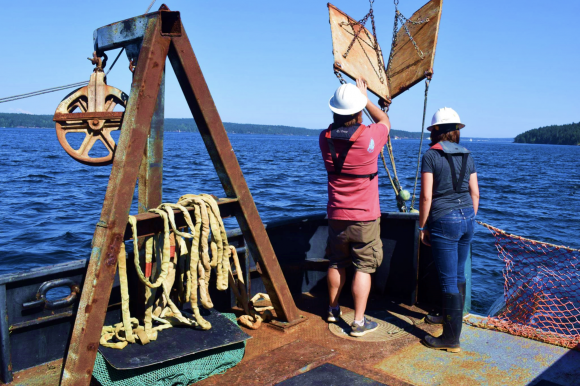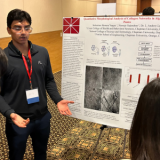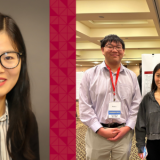
Chapman Faculty Lets Nature Be Her Guide Through Bio-Inspired Research and Design Diving deep into Dr. Cassandra Donatelli’s groundbreaking work in biomechanics
June 15, 2023
For many engineers, inspiration for advanced mechanical designs doesn’t come exclusively from man-made technologies; instead, these researchers turn to nature for key insight. Upon joining the Fowler School of Engineering (FSE) community last August, Assistant Professor and biomechanist Dr. Cassandra Donatelli began collaborating with her students and fellow faculty members as they dug deep into the heart of engineering, developing designs to directly enhance the human experience.
Donatelli’s research pursues this goal through biomechanics, a field that applies basic physics and engineering principles to living biological systems to better understand how they work and move. By studying what helps humans walk or birds fly, Donatelli explains that engineers can develop new ideas for composite materials, or products constructed from multiple different substances. These biomimetic designs can be widely adapted for a plethora of uses; in her 2022 publication entitled “MONOLITh: a soft non-pneumatic foam robot with a functional mesh skin for use in delicate environments,” Donatelli explores how analyzing the soft body walls of larval insects like caterpillars can influence key advancements in robotics.
“On a very basic level, sometimes we just see a cool animal out in the world and want to know how and why it works, answering the big questions around how life and motion have evolved on Earth,” said Donatelli. “However, on a larger scale, this work is so integrative: it uses many different techniques and can be applied across fields. People might take inspiration from my study on how one fish swims and can use that to figure out how to help humans swim faster. Biomechanics focuses on making our lives better—animals have figured it out over millions of years of evolution, so why not use what they’re already doing to improve the way we interact with the world?”

Donatelli’s focus on fish locomotion has led her to split research time between both lab and field experiences. Many of the latter have taken place at the University of Washington Friday Harbor Marine Lab, where she has spent nine summers studying the intersection of fish and biomechanics alongside students and faculty.
Due to the interdisciplinarity of her work, Donatelli finds it useful to describe classroom concepts through her own tangible research. This effort bridges gaps between understanding abstract ideas and engaging with course material, utilizing real-world examples that students across STEM programs might encounter in their own industry or academic careers. “While biomechanics can lean heavily toward either engineering or biology, I’ve struck a balance between the two. I use a lot of engineering techniques like programming and material testing to answer biology questions and vice versa. This means I can give a lot of examples directly from my research in my programming classes, like how I would organize my fish data using Python. I try to use marine biology and fish examples to cement the ideas,” shared Donatelli.
For Donatelli, some of her most fulfilling research experiences involve working with her students—both in and out of the classroom. At the end of the spring 2023 semester, Donatelli brought a group of students to a conference hosted by the Southern California Academy of the Sciences. While there, she celebrated and supported her students as they presented their work to peers and experts alike, citing this as her favorite accomplishment from her first year among Fowler Engineering faculty.
“It always makes me really happy when my students can share their work with the broader community,” Donatelli said. “I enjoy being able to take them places and show them new experiences, especially those outside of Chapman’s walls. I’m working with a bunch of them again this summer and I’m really excited about the work that we’re doing; it’s the perfect time to dive deep into research.”
In Donatelli’s experience, students can struggle with seeking faculty mentorship opportunities, so her biggest advice for those interested in research is to simply focus on getting their foot in the door: “Any faculty member you’d want to work with would be more than happy to respond to an email and talk to you about research … we’re friendly and we want to help—it’s the whole reason we do this! Never worry about reaching out or asking silly questions.”

As a structural engineer and comparative biomechanist, Donatelli has dedicated significant time to studying the differently-shaped vertebrae of swimming animals. This process involves both sitting down at a computer to write complex software and physically being out on the ocean with fellow researchers.
While not all challenges within biomechanical research are easy or possible to overcome, Donatelli approaches them with a realistic yet inquisitive attitude and a smile, encouraging her students and colleagues to do the same. “Life is not as easy as we try to simplify it to be; humans and animals are very complicated creatures,” shared Donatelli. “Trying to figure out how to take walking, swimming, or running and make it simple enough that we can actually do math on it and write programs about it is a big challenge we spend a lot of our time on, and this results in some pretty cool products. The hardest part of engineering composite materials is translating the crazy complexity that is life and trying to simplify it enough so we can actually work with it in the lab. I have not solved it—I don’t think we ever will—but that’s all part of the fun.”
The next steps in Donatelli’s own research journey involve continuing her study of biological armor, analyzing the different ways it has evolved across the tree of life. Through her research, unlocking the secrets to armor functionality can open doors for advanced, human-centered technology.
“I want to discover all the different ways animals use armor in nature (what shapes are good for what functions) and then create composite materials that we can use in our lives. For example, if armor is really good at restricting motion, maybe we can use that model to design a knee brace,” stated Donatelli. “My big picture goals are figuring out what different types of armor exist, how it’s made, and how we can use it to make the world a better place.”
Donatelli encourages students interested in pursuing research opportunities with her to reach out through Chapman email (donatell@chapman.edu) or via Slack.

